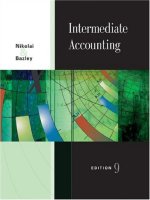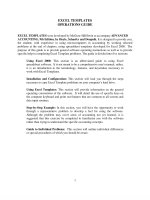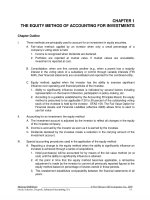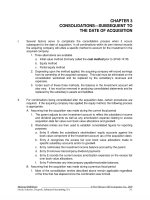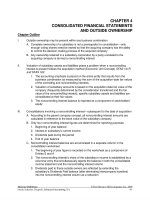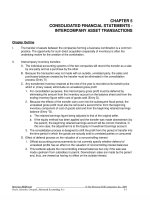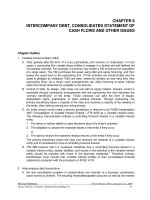Solution manual advanced accounting 9e by hoyle ch04
Bạn đang xem bản rút gọn của tài liệu. Xem và tải ngay bản đầy đủ của tài liệu tại đây (882.7 KB, 49 trang )
Find more slides, ebooks, solution manual and testbank on www.downloadslide.com
CHAPTER 4
CONSOLIDATED FINANCIAL STATEMENTS
AND OUTSIDE OWNERSHIP
Chapter Outline
I.
Outside ownership may be present within any business combination
A. Complete ownership of a subsidiary is not a prerequisite for consolidation—only
enough voting shares need be owned so that the acquiring company has the ability
to control the decision-making process of the acquired company
B. Any ownership retained in a subsidiary corporation by a party unrelated to the
acquiring company is termed a noncontrolling interest
II.
Valuation of subsidiary assets and liabilities poses a problem when a noncontrolling
interest is present follows the acquisition method (Economic Unit Concept) SFAS 141R
and SFAS 160
1. The accounting emphasis is placed on the entire entity that results from the
business combination as measured by the sum of the acquisition-date fair values
of the controlling and noncontrolling interests.
2. Valuation of subsidiary accounts is based on the acquisition-date fair value of the
company (frequently determined by the consideration transferred and the fair
value of the noncontrolling interest); specific subsidiary assets and liabilities are
consolidated at their fair values
3. The noncontrolling interest balance is reported as a component of stockholders'
equity
III.
Consolidations involving a noncontrolling interest—subsequent to the date of acquisition
A. According to the parent company concept, all noncontrolling interest amounts are
calculated in reference to the book value of the subsidiary company
B. Only four noncontrolling interest figures are determined for reporting purposes
1. Beginning of year balance
2. Interest in subsidiary’s current income
3. Dividends paid during the period
4. End of year balance
C. Noncontrolling interest balances are accumulated in a separate column in the
consolidation worksheet
1. The beginning of year figure is recorded on the worksheet as a component of
Entries S and A
2. The noncontrolling interest's share of the subsidiary's income is established by a
columnar entry that simultaneously reports the balance in both the consolidated
income statement and the noncontrolling interest column
3. Dividends paid to these outside owners are reflected by extending the
subsidiary's Dividends Paid balance (after eliminating intercompany transfers)
into the noncontrolling interest column as a reduction
McGraw-Hill/Irwin
Hoyle, Schaefer, Doupnik, Advanced Accounting, 9/e
© The McGraw-Hill Companies, Inc., 2009
4-1
Find more slides, ebooks, solution manual and testbank on www.downloadslide.com
4. The end of year noncontrolling interest total is the summation of the three items
above and is reported (in this book) between consolidated liabilities and
stockholders' equity
IV.
Step acquisitions
A. An acquiring company may make several different purchases of a subsidiary's stock
in order to gain control
B. Upon attaining control, all of the parent’s previous investments in the subsidiary are
adjusted to fair value and a gain or loss recognized as appropriate
C. Upon attaining control, the valuation basis for the subsidiary is established at its total
fair value (the sum of the fair values of the controlling and noncontrolling interests)
Vl.
Sales of subsidiary stock
A. The proper book value must be established within the parent's Investment account
so that the sales transaction can be correctly recorded
B. The investment balance is adjusted as if the equity method had been applied during
the entire period of ownership
C. If only a portion of the shares are being sold, the book value of the investment
account must be reduced based on either a FIFO or a weighted-average cost flow
assumption
D. If the parent maintains control, any difference between the proceeds of the sale and
the equity-adjusted book value of the share sold is recognized as an adjustment to
additional paid-in capital.
E. If the parent loses control with the sale of the subsidiary shares, the difference
between the proceeds of the sale and the equity-adjusted book value of the share
sold is recognized as a gain or loss.
F. Any interest retained by the parent company should be accounted for by either
consolidation, the equity method, or the fair value method depending on the
influence remaining after the sale.
Learning Objectives
Upon completion of Chapter Four, "Consolidated Financial Statements and Outside
Ownership," students should be able to fulfill each of the following learning objectives:
1.
Realize that complete ownership is not a prerequisite for the formation of a business
combination.
2.
Understand the meaning of the term "noncontrolling interest.”
3.
Explain the rationale underlying the acquisition method for accounting for the
noncontrolling interest.
4.
Identify appropriate balance sheet placements for the components of the noncontrolling
interest in consolidated financial statements.
5.
Identify and calculate the four noncontrolling interest figures that must be included within
the consolidation process and be able to enter each balance on a consolidation
worksheet.
McGraw-Hill/Irwin
4-2
© The McGraw-Hill Companies, Inc., 2009
Solutions Manual
Find more slides, ebooks, solution manual and testbank on www.downloadslide.com
6.
Carry out a consolidation when a step acquisition has taken place.
7.
Record the sale of a subsidiary (or a portion of its shares) when the parent has been
applying either the Initial value method, the equity method, or the partial equity method.
8.
Select an appropriate method by which to account for any shares remaining after the sale
of a portion of an investment in a subsidiary company.
Answers to Questions
1.
"Noncontrolling interest" refers to an equity interest that is held in a member of a
business combination by an unrelated (outside) party.
2.
a. Acquisition method = $220,000 (fair value)
b. Purchase method = $208,000 (all of the book value plus 80 percent of the $60,000
difference between fair value and book value)
3.
A control premium is the portion of an acquisition price (above currently traded market
values) paid by a parent company to induce shareholders to sell a sufficient number of
shares to obtain control. The extra payment typically becomes part of the goodwill
acquired in the acquisition attributable to the parent company.
4.
In practice, noncontrolling interest figures will appear in various locations within
consolidated financial statements. The end of year balance can be found in the liability
section, in the stockholders' equity section, or between these two. The noncontrolling
interest's share of net income can be shown as a reduction on either the income
statement or the statement of retained earnings. Based on current practice, this textbook
reports the ending balance between consolidated liabilities and stockholders' equity with
the income allocation shown as a reduction on the income statement.
5.
The ending noncontrolling interest can be determined on a consolidation worksheet by
adding the components found in the noncontrolling interest column: the beginning
balance plus allocation of current year net income less dividends paid to these outside
owners. The ending balance can also be determined (at this point in the exploration of
consolidated financial statements) by multiplying the outside ownership percentage by
the subsidiary's ending book value. In subsequent chapters, this calculation must be
altered because of various adjustments made within the consolidation process.
6.
Allsports should remove the pre-acquisition revenues and expenses from the
consolidated totals. These amounts have been earned (incurred) prior to ownership by
Allsports and therefore should not be reported as earnings for the current parent
company owners.
7.
In previous years, Tree has appropriately utilized the market-value method in accounting
for its investment in Limb. Now, following a second acquisition, consolidation has
become applicable. These two methods are not considered to be comparable.
Therefore, at the point in time that Tree begins to produce consolidated statements, all
previous financial reports must be restated as if the equity method had been applied
since the date of the first acquisition. This handling presents the reader of the financial
statements with figures that are more comparable from year to year.
McGraw-Hill/Irwin
Hoyle, Schaefer, Doupnik, Advanced Accounting, 9/e
© The McGraw-Hill Companies, Inc., 2009
4-3
Find more slides, ebooks, solution manual and testbank on www.downloadslide.com
8.
When a company sells a portion of an investment, a gain or loss is recognized based on
the difference between the proceeds received and the book value of the investment (on
the portion sold). The correct book value is determined based upon the consistent
application of the equity method. Thus, if either the Initial value method or the partial
equity method has been used, Duke must first restate the account to the equity method
before recording the sales transaction. This same method is also applied to the
operations of the current period occurring prior to the time of sale.
9.
Unless control is surrendered, the acquisition method views the sale of subsidiary's
stock as a treasury stock transaction. Thus, no gain or loss can be recognized.
10.
The accounting method choice for the remaining shares depends upon the current
relationship between the two firms. If Duke retains control, consolidation is still required.
However, if the parent now can only significantly influence the decision-making process,
the equity method is applied. A third possibility is Duke may have lost the power to
exercise even significant influence. The market-value method then is appropriate.
McGraw-Hill/Irwin
4-4
© The McGraw-Hill Companies, Inc., 2009
Solutions Manual
Find more slides, ebooks, solution manual and testbank on www.downloadslide.com
Answers to Problems
1. D The acquisition method consolidates assets at fair value at acquisition date
regardless of the parent’s percentage ownership.
2. D In consolidating the subsidiary's figures, all intercompany balances must
be eliminated in their entirety for external reporting purposes. Even
though the subsidiary is less than fully owned, the parent nonetheless
controls it.
3. C An asset acquired in a business combination is initially valued at 100%
acquisition-date fair value and subsequently amortized its useful life.
Patent fair value at January 1, 2009 ..............................................
Amortization for 2 years (10 year life) ...........................................
Patent reported amount December 31, 2010 ................................
4. A Plaster building ..............................................................................
Turner building acquisition-date fair value
$300,000
Amortization for 3 years (10-year life)
(90,000)
Consolidated buildings .................................................................
$45,000
(9,000)
$36,000
$510,000
210,000
$720,000
-ORPlaster building .............................................................................. $510,000
Turner building 12/31/11
$182,000
Excess acquisition-date fair value allocation
40,000
Excess amortization for 3 years (10-year life)
(12,000) 210,000
Consolidated buildings ................................................................. $720,000
5. C Hygille expense .............................................................................. $621,000
Nuyt expenses ................................................................................
714,000
Excess fair value amortization (70,000 ÷ 10 yrs) ..........................
7,000
Consolidated expenses ................................................................. $1,342,000
6. B Combined revenues ....................................................................... $1,100,000
Combined expenses ......................................................................
(700,000)
Excess acquisition-date fair value amortization ..........................
(15,000)
Consolidated net income ............................................................... $385,000
Less: noncontrolling interest ($85,000 × 40%) .............................
(34,000)
Consolidated net income to controlling interest ......................... $351,000
7. C
8. B
McGraw-Hill/Irwin
Hoyle, Schaefer, Doupnik, Advanced Accounting, 9/e
© The McGraw-Hill Companies, Inc., 2009
4-5
Find more slides, ebooks, solution manual and testbank on www.downloadslide.com
McGraw-Hill/Irwin
4-6
© The McGraw-Hill Companies, Inc., 2009
Solutions Manual
Find more slides, ebooks, solution manual and testbank on www.downloadslide.com
9. A Amie, Inc. Fair value at January 1, 2007:
30% previously owned fair value (30,000 shares × $5) ................
60% new shares acquired (60,000 shares × $6) ............................
10% NCI fair value (10,000 shares × $5) ........................................
Acquisition-date fair value .............................................................
Net assets' fair value ......................................................................
Goodwill .........................................................................................
$150,000
360,000
50,000
$560,000
500,000
$60,000
11. A Fair value of noncontrolling interest on April 1 ...........................
30% of net income for 9 months (¾ year × $240,000 × 30%) .......
Noncontrolling interest December 31 ...........................................
$165,000
54,000
$219,000
10. C
12. B Combined revenues ....................................................................... $1,300,000
Combined expenses ......................................................................
(800,000)
Trademark amortization .................................................................
(6,000)
Patented technology amortization ................................................
(8,000)
Consolidated net income ............................................................... $486,000
13. C Subsidiary income ($100,000 – $14,000 excess amortizations) ..
Noncontrolling interest percentage ..............................................
Noncontrolling interest in subsidiary income ..............................
$86,000
40%
$34,400
Fair value of noncontrolling interest at acquisition date ............
40% change in Scott book value since acquisition .....................
Excess fair value amortization ($14,000 × 40%) ...........................
40% current year income ...............................................................
Noncontrolling interest at end of year ..........................................
$180,000
52,000
(5,600)
34,400
$260,800
14. A Michael trademark balance ............................................................
Scott trademark balance ................................................................
Excess fair value ............................................................................
Two years amortization (10-year life) ............................................
Consolidated trademarks ..............................................................
$260,000
200,000
60,000
(12,000)
$508,000
McGraw-Hill/Irwin
Hoyle, Schaefer, Doupnik, Advanced Accounting, 9/e
© The McGraw-Hill Companies, Inc., 2009
4-7
Find more slides, ebooks, solution manual and testbank on www.downloadslide.com
15. A Acquisition-date fair value ($60,000 ÷ 80%) ..................................
Strand's book value ......................................................................
Fair value in excess of book value ...............................................
$75,000
(50,000)
$25,000
Excess assigned to inventory (60%) ................................$15,000
Excess assigned to goodwill (40%) .................................$10,000
Park current assets ........................................................................
Strand current assets.....................................................................
Excess inventory fair value ...........................................................
Consolidated current assets .........................................................
$70,000
20,000
15,000
$105,000
16. D Park noncurrent assets ..................................................................
Strand noncurrent assets ..............................................................
Excess fair value to goodwill ........................................................
Consolidated noncurrent assets ...................................................
$90,000
40,000
10,000
$140,000
17. B Add the two book values and include 10% (the $6,000 current portion) of
the loan taken out by Park to acquire Strand.
18. B Add the two book values and include 90% (the $54,000 noncurrent portion)
of the loan taken out by Polk to acquire Strand.
19. C Park stockholders' equity ..............................................................
Noncontrolling interest at fair value (20% × $75,000) ..................
Total stockholders' equity .............................................................
20.
$80,000
15,000
$95,000
(15 minutes) (Compute consolidated income and noncontrolling interests)
Harrison income ............................................................
Starr income ..................................................................
Excess fair value amortization .....................................
Consolidated net income ..............................................
2009
$220,000
70,000
(8,000)
$282,000
2010
$260,000
90,000
(8,000)
$342,000
Starr fair value ................................................................................ $1,200,000
Fair value of consideration transferred ........................................ 1,125,000
Noncontrolling interest fair value .................................................
$75,000
Noncontrolling interest fair value January 1, 2009 (above) ..........
2009 income to NCI ([$70,000 – $8,000] × 10%)................................
2009 dividends to NCI ...................................................................
Noncontrolling interest reported value December 31, 2009 ........
2010 income to NCI ([$90,000 – $8,000] × 10%)................................
2010 dividends to NCI ...................................................................
Noncontrolling interest reported value December 31, 2010
McGraw-Hill/Irwin
4-8
$75,000
6,200
(3,000)
78,200
8,200
(3,000)
$83,400
© The McGraw-Hill Companies, Inc., 2009
Solutions Manual
Find more slides, ebooks, solution manual and testbank on www.downloadslide.com
McGraw-Hill/Irwin
Hoyle, Schaefer, Doupnik, Advanced Accounting, 9/e
© The McGraw-Hill Companies, Inc., 2009
4-9
Find more slides, ebooks, solution manual and testbank on www.downloadslide.com
21. (40 minutes) (Several valuation and income determination questions for a
business combination involving a noncontrolling interest.)
a. Business combinations are recorded generally at the fair value of the
consideration transferred by the acquiring firm plus the acquisition-date fair
value of the noncontrolling interest.
Patterson’s consideration transferred ($31.25 × 80,000 shares) ......... $2,500,000
Noncontrolling interest fair value ($30.00 × 20,000 shares) ................ $600,000
Soriano’s total fair value 1/1/09 .......................................................... $3,100,000
b. Each identifiable asset acquired and liability assumed in a business
combination should initially be reported at its acquisition-date fair value.
c. In periods subsequent to acquisition, the subsidiary’s assets and liabilities are
reported at their acquisition-date fair values adjusted for amortization and
depreciation. Except for certain financial items, they are not continually
adjusted for changing fair values.
d. Soriano’s total fair value 1/1/09 .......................................................... $3,100,000
Soriano’s net assets book value ........................................................ 1,290,000
Excess acquisition-date fair value over book value.......................... $1,810,000
Adjustments from book to fair values ................................................
Buildings and equipment .................................... (250,000)
Trademarks...........................................................
200,000
Patented technology ............................................ 1,060,000
Unpatented technology .......................................
600,000
1,610,000
Goodwill
......................................................................................... $ 200,000
e. Combined revenues ............................................................................ $4,400,000
Combined expenses ............................................................................ (2,350,000)
Building and equipment excess depreciation ...................................
50,000
Trademark excess amortization .........................................................
(20,000)
Patented technology amortization .....................................................
(265,000)
Unpatented technology amortization .................................................
(200,000)
Consolidated net income .................................................................... $1,615,000
To noncontrolling interest:
Soriano’s revenues ........................................................................ $1,400,000
Soriano’s expenses ........................................................................
(600,000)
Total excess amortization expenses (above) ...............................
(435,000)
Soriano’s adjusted net income...................................................... $365,000
Noncontrolling interest percentage ownership ...........................
20%
Noncontrolling interest share of consolidated net income .........
$73,000
McGraw-Hill/Irwin
4-10
© The McGraw-Hill Companies, Inc., 2009
Solutions Manual
Find more slides, ebooks, solution manual and testbank on www.downloadslide.com
To controlling interest:
Consolidated net income ............................................................... $1,615,000
Noncontrolling interest share of consolidated net income .........
(73,000)
Controlling interest share of consolidated net income ............... $1,542,000
-ORPatterson’s revenues ..................................................................... $3,000,000
Patterson’s expenses..................................................................... 1,750,000
Patterson’s separate net income................................................... $1,250,000
Patterson’s share of Soriano’s adjusted net income
(80% × $365,000) ..................................................................
292,000
Controlling interest share of consolidated net income ............... $1,542,000
f. Fair value of noncontrolling interest January 1, 2009.......................
2009 income .........................................................................................
Dividends (20% × $30,000) ..................................................................
Noncontrolling interest December 31, 2009.......................................
$600,000
73,000
(6,000)
$ 667,000
g. If Soriano’s acquisition-date total fair value was $2,250,000, then a bargain
purchase has occurred.
Soriano’s total fair value 1/1/09 .......................................................... $2,250,000
Collective fair values of Soriano’s net assets ................................... $2,300,000
Bargain purchase ................................................................................
$50,000
The acquisition method requires that the subsidiary assets acquired and
liabilities assumed be recognized at their acquisition date fair values
regardless of the assessed fair value. Therefore, none of Soriano’s identifiable
assets and liabilities would change as a result of the assessed fair value.
When a bargain purchase occurs, however, no goodwill is recognized.
McGraw-Hill/Irwin
Hoyle, Schaefer, Doupnik, Advanced Accounting, 9/e
© The McGraw-Hill Companies, Inc., 2009
4-11
Find more slides, ebooks, solution manual and testbank on www.downloadslide.com
22. (20 Minutes) (Determine consolidated income balances, includes a mid-year
acquisition)
a.
Acquisition-date total fair value ......................... $594,000
Book value of net assets ..................................... (400,000)
Fair value in excess of book value .................... $194,000
Annual Excess
Excess fair value assigned to
Life Amortizations
Patent ......................................................... 140,000 5 years
$28,000
Land
.........................................................
10,000
Buildings .......................................................
30,000 10 years
3,000
Goodwill ........................................................
14,000
Total
.........................................................
-0$31,000
Consolidated figures following January 1 acquisition date:
Combined revenues ........................................................................... $1,500,000
Combined expenses ............................................................................ (1,031,000)
Consolidated net income ....................................................................
469,000
NCI in Sawyer’s income ([200,000 – 31,000] × 30%) .............................
(50,700)
Controlling interest in consolidated net income .............................. $418,300
b. Consolidated figures following April 1 acquisition date:
Combined revenues (1) ....................................................................... $1,350,000
Combined expenses (2) .......................................................................
(923,250)
Consolidated net income ................................................................... $426,750
Noncontrolling interest in subsidiary income (3) ..............................
(38,025)
Controlling interest in consolidated net income .............................. $388,725
(1) $900,000 Parker revenues plus $450,000 of post-acquisition Sawyer revenues
(2) $600,000 Parker expenses plus $300,000 of post-acquisition Sawyer expenses
plus $23,250 amortization expenses for 9 months
(3) ($200,000 – 31,000) adjusted subsidiary income × 30% × ¾ year
McGraw-Hill/Irwin
4-12
© The McGraw-Hill Companies, Inc., 2009
Solutions Manual
Find more slides, ebooks, solution manual and testbank on www.downloadslide.com
23.
(15 minutes) Consolidated figures with noncontrolling interest
Fair value of company (given)
Book value
Fair value in excess of book value
to machine ($50,000 – $10,000)
to process trade secret
$60,000
(10,000)
50,000
40,000 ÷ 10 = $4,000 per year
$10,000 ÷ 4 = 2,500 per year
$6,500 per year
Consolidated figures:
Noncontrolling interest in subsidiary income
= 40% ($50,000 revenues less $26,500 expenses) = $9,400
End-of-year noncontrolling interest:
Beginning balance (40% $60,000)
Income allocation
Dividend reduction (40% $5,000)
End-of-year noncontrolling interest
24.
$24,000
9,400
(2,000)
$31,400
Machine (net) = $45,000 ($9,000 book value plus $40,000 excess
allocation less $4,000 excess depreciation for one year).
Process trade secret (net) = $10,000 – $2,500 = $7,500
(20 Minutes) (Determine consolidated balances for a step acquisition).
a. Amsterdam fair value implied by price paid by Morey
$560,000 ÷ 70% =
$800,000
b. Revaluation gain
1/1 equity investment in Amsterdam (book value)
25% income for 1st 6 months
Investment book value at 6/30
Fair value of investment
Gain on revaluation to fair value
$178,000
8,750
186,750
200,000
$13,250
c. Goodwill at 12/31
Fair value of Amsterdam at 6/30
Book value at 6/30 (700,000 + [70,000 ÷ 2])
Excess fair value
Allocation to goodwill (no impairment)
$800,000
735,000
$65,000
$65,000
d. Noncontrolling interest
5% fair value balance at 6/30
5% Income from 6/30 to 12/31
5% dividends
Noncontrolling interest 12/31
McGraw-Hill/Irwin
Hoyle, Schaefer, Doupnik, Advanced Accounting, 9/e
$40,000
1,750
(1,000)
$40,750
© The McGraw-Hill Companies, Inc., 2009
4-13
Find more slides, ebooks, solution manual and testbank on www.downloadslide.com
25. (30 Minutes) (Reporting the sale of a portion of an investment in a subsidiary.)
a. The 1,000 shares sold are reported using the equity method for the
January 1, 2011 until October 1, 2011 period. This stock represents 10
percent of the outstanding shares of Santana. An accrual of $9,000 is
recorded by Girardi (10% × $120,000 × ¾ year) reduced by $1,500 in
amortization expense as computed below. Therefore, an "Equity Income
from Sold Shares of Santana" in the amount of $7,500 will appear in the
2011 consolidated income statement. The consolidation will now
include all of Santana's accounts with the 40% noncontrolling interest
recognized.
Santana fair value 1/1/09 ..........................................
Santana book value .................................................
Patent ........................................................................
Life of patent ............................................................
Annual amortization .................................................
9-months amortization for the 1,000 shares sold:
Annual amortization .................................................
Time period involved ...............................................
Amortization for nine months .................................
Shares sold—1,000 out of 7,000 ..............................
Amortization relating to sold shares ......................
$1,100,000
(1,030,000)
$70,000
5 years
$14,000
$14,000
¾ year
$10,500
1/7
$1,500
b. As long as control is maintained, the acquisition method considers
transactions in the stock of a subsidiary, whether purchases or sales,
as transactions in the equity of the consolidated entity.
Investment Book Value 10/1/11
1/1/11 balance (given—equity method) ..................
Recognition of 1/1/11–10/1/11 period:
Income accrual ($120,000 × 70% × ¾) ................
Dividends ($40,000 × 70% × ¾) ..........................
Amortization ($14,000 × ¾) .................................
Correct investment book value—10/1/11 .................
Computation of Income Effect—Sales Transaction
10/1/11 book value (above) ......................................
Portion of investment sold (1,000/7,000 shares) ....
Book value of investment sold ...............................
Proceeds ...................................................................
Credit to Girardi’s additional paid-in capital ..........
McGraw-Hill/Irwin
4-14
$1,085,000
63,000
(21,000)
(10,500)
$1,116,500
$1,116,500
1/7
$159,500
191,000
$ 31,500
© The McGraw-Hill Companies, Inc., 2009
Solutions Manual
Find more slides, ebooks, solution manual and testbank on www.downloadslide.com
c. Because Girardi continues to hold 6,000 shares of Santana, control is
still maintained and consolidated financial statements would be
appropriate with a noncontrolling interest of 40 percent.
26.
(35 Minutes) (Consolidation entries and the effect of different investment
methods)
a. From the original fair value allocation, $30,000 is assigned based on the
fair value of the patent. With a 5-year life, excess amortization will be
$6,000 per year.
Because the equity method is in use, no Entry *C is required.
Entry S
Common Stock (Bandmor) ........................... 300,000
Retained Earnings, 1/1/11(Bandmor) ............ 268,000
Investment in Bandmor (70%) .................
397,600
Noncontrolling Interest in Bandmor, 1/1/11
170,400
(To eliminate stockholders' equity accounts of subsidiary and
recognize outside ownership. Retained earnings figure includes 2009
and 2010 income and dividends.)
Entry A
Patent ............................................................. 18,000
Goodwill ......................................................... 190,000
Investment in Bandmor ............................
145,600
Noncontrolling Interest in Bandmor (30%)
62,400
(To recognize unamortized portions of acquisition-date fair value
allocations. Patent has undergone two years amortization)
Entry I
Equity in Subsidiary Earnings ...................... 72,800
Investment in Bandmor ............................
72,800
(To eliminate intercompany income balance. Equity accrual of
$72,800 [70% × ($110,000 – 6,000 amortization)] has been recorded)
Entry D
Investment in Bandmor ................................. 42,000
Dividends Paid ..........................................
42,000
(To eliminate current intercompany dividend transfers—70% of
$60,000)
Entry E
Amortization Expense ....................................
Patent .........................................................
(To recognize amortization for current year)
6,000
Entry P
Accounts Payable .......................................... 22,000
Accounts Receivable ................................
(To eliminate intercompany payable/receivable balance)
McGraw-Hill/Irwin
Hoyle, Schaefer, Doupnik, Advanced Accounting, 9/e
6,000
22,000
© The McGraw-Hill Companies, Inc., 2009
4-15
Find more slides, ebooks, solution manual and testbank on www.downloadslide.com
26. (continued)
b. If the initial value method had been applied, the parent would have
recorded only the dividends received as income rather than an equity
accrual. Therefore, Entry *C is needed to adjust the parent's beginning
retained earnings for 2011 to the equity method. During 2009 and 2010,
the subsidiary earned a total net income of $171,000 but paid dividends
of only $83,000. The parent's share of the difference is $61,600 (70% of
$88,000 [$171,000 - $83,000]). In addition, the parent’s 70% share of
excess amortization expense for two years must also be included
($8,400 = 2 years × $6,000 per year × 70%). The net amount to be
recognized is $53,200 ($61,600 - $8,400).
ENTRY *C
Investment in Bandmor .................................
Retained Earnings, 1/1/11 ........................
53,200
53,200
c. If the partial equity method had been applied, only the excess
amortization expenses for the previous two years would have been
omitted from the parent's retained earnings. As shown above, that
figure is $8,400 (2 years × $6,000 per year × 70%).
ENTRY *C
Retained Earnings, 1/1/11 .............................
Investment in Bandmor ............................
8,400
8,400
d. Noncontrolling interest in Bandmor's income—2011
[($110,000 – 6,000) × 30%] .............................
$31,200
Noncontrolling interest fair value January 1, 2009
$210,000
Adjustments to original basis:
2009 Net Income to NCI .....................................
$20,700
Dividends paid ..........................................
(11,700)
9,000
2010 Net income to NCI ....................................
Dividends paid ..........................................
$27,000
(13,200)
2011 Net income to NCI .....................................
Dividends paid ..........................................
Noncontrolling interest in Bandmor 12/31/11 ....
$31,200
(18,000)
13,800
13,200
$246,000
–OR–
Worksheet adjustment S ....................................................
Worksheet adjustment A ....................................................
2009 income to noncontrolling interest ...........................
2009 dividends to noncontrolling interest .......................
Noncontrolling interest in Bandmor 12/31/11 ...................
McGraw-Hill/Irwin
4-16
$170,400
$62,400
31,200
(18,000)
$246,000
© The McGraw-Hill Companies, Inc., 2009
Solutions Manual
Find more slides, ebooks, solution manual and testbank on www.downloadslide.com
27.
(45 Minutes) (Asks about several consolidated balances and consolidation
process. Includes the different accounting methods to record investment.)
a. Schedule 1—Fair Value Allocation and Excess Amortizations
Consideration transferred by Miller ........ $664,000
Noncontrolling interest fair value ............ 166,000
Taylor’s fair value...................................... $830,000
Taylor’s book value................................... (600,000)
Fair value in excess of book value ......... 230,000
Excess fair value assigned to buildings
Annual Excess
Life Amortizations
80,000
20 years
Goodwill ................................................... $150,000 indefinite
Total ......................................................
$4,000
-0$4,000
b. $150,000 (see schedule 1 above)
c. Entry (S)
Common Stock (Taylor) ......................................
Additional Paid-in Capital (Taylor) .....................
Retained Earnings (Taylor) .................................
Investment in Taylor Company (80%) ...........
Noncontrolling interest in Taylor (20%) .......
Entry (A)
Buildings .............................................................
Goodwill ..............................................................
Investment in Taylor Company (80%) ...........
Noncontrolling interest in Taylor (20%) .......
d. (1) Equity Method
Income accrual (80%) ....................................
Excess amortization expense .......................
Investment income ...................................
300,000
90,000
210,000
480,000
120,000
80,000
150,000
184,000
46,000
$56,000
(3,200)
$52,800
(2) Partial Equity Method
Income accrual (80%) ....................................
$56,000
(3) Initial Value Method
Dividends received (80%) ..............................
$8,000
e. Equity Method
Initial fair value paid ............................................
Income accrual 2009–2011 ($260,000 × 80%) ....
Dividends 2009–2011 ($45,000 × 80%) ...............
Excess Amortizations 2009–2011 ($3,200 × 3) ..
Investment in Taylor—12/31/11 .....................
McGraw-Hill/Irwin
Hoyle, Schaefer, Doupnik, Advanced Accounting, 9/e
$664,000
208,000
(36,000)
(9,600)
$826,400
© The McGraw-Hill Companies, Inc., 2009
4-17
Find more slides, ebooks, solution manual and testbank on www.downloadslide.com
27. (continued)
Partial Equity Method
Investment in Taylor—12/31/11 = $836,000 (initial value paid plus income
accrual of $208,000 less dividends of $36,000 [no excess amortizations])
Initial Value Method
Investment in Taylor—12/31/11 = $664,000 (original value paid)
f. Using the acquisition method, the allocation will be the total difference
($80,000) between the buildings' book value and fair value. Based on a
20 year life, annual excess amortization is $4,000.
Miller book value—buildings ............................. $800,000
Taylor book value—buildings ............................
300,000
Allocation ............................................................
80,000
Excess Amortizations for 2009–2010 ($4,000 × 2)
(8,000)
Consolidated buildings account ............. $1,172,000
g. Acquisition-date fair value allocated to goodwill
(see schedule 1 above) .................................. $150,000
h. If the parent has been applying the equity method, the stockholders'
equity accounts on its books will already represent consolidated totals.
The common stock and additional paid-in capital figures to be reported
are the parent balances only. As to retained earnings, the equity method
will properly record all subsidiary income and amortization so that the
parent balance is also a reflection of the consolidated total.
McGraw-Hill/Irwin
4-18
© The McGraw-Hill Companies, Inc., 2009
Solutions Manual
Find more slides, ebooks, solution manual and testbank on www.downloadslide.com
28.
(20 Minutes) (A variety of consolidated balances-midyear acquisition)
Book value of Reckers, 1/1
(stockholders' equity accounts) ..............
Increase in book value:
Net Income (revenues less cost of
goods sold and expenses) ................. $120,000
Dividends ............................................
(20,000)
Change during year ................................. $100,000
Change during first six months of year
Book value of Reckers, 7/1 (acquisition date)
$1,400,000
50,000
$1,450,000
Consideration transferred by Kaplan ........... $1,360,000
Noncontrolling interest fair value ................
300,000
Reckers’ fair value (given) ............................. $1,630,000
Book value of Reckers ................................... (1,450,000)
Fair value in excess of book value ................ $180,000
Annual Excess
Excess fair value assigned
Life Amortizations
Trademarks .................................................
150,000 5 years $30,000
Goodwill ......................................................
$60,000 indefinite
-0Total
.........................................................
$30,000
CONSOLIDATION TOTALS:
Sales (1)
$1,050,000
Cost of goods sold (2)
540,000
Operating expenses (3)
265,000
Net Income
Noncontrolling Interest in sub. Income (4)
$245,000
$9,000
(1) $800,000 Kaplan revenues plus $250,000 (post-acquisition subsidiary
revenue)
(2) $400,000 Kaplan COGS plus $140,000 (post-acquisition subsidiary COGS)
(3) $200,000 Kaplan operating expenses plus $50,000 (post-acquisition
subsidiary operating expenses) plus ½ year excess amortization of $15,000
(4) 20% of post-acquisition subsidiary income less excess fair value
amortization [20% × (120,000 – 30,000) × ½ year] = $9,000
Retained Earnings, 1/1 = $1,400,000 (the parent’s balance because the
subsidiary was acquired during the current year)
Trademark = $935,000 (add the two book values and the excess fair
value allocation after taking one-half year excess amortization)
Goodwill = $60,000 (the original allocation)
McGraw-Hill/Irwin
Hoyle, Schaefer, Doupnik, Advanced Accounting, 9/e
© The McGraw-Hill Companies, Inc., 2009
4-19
Find more slides, ebooks, solution manual and testbank on www.downloadslide.com
29.
(25 Minutes) (A variety of consolidated questions and balances)
a. Nascent applies the initial value method because the original price of
$414,000 is still in the Investment in Sea-Breeze account. In addition, the
Investment Income account is equal to 60 percent of the dividends paid
by the subsidiary during the year.
b. Consideration transferred in acquisition $414,000
Noncontrolling interest fair value ............ 276,000
Sea-Breeze fair value 1/1/09 .................... $690,000
Sea-Breeze book value 1/1/09
550,000
Excess fair value over book value
$140,000
Excess fair assignments:
Buildings ..............................................
Equipment ............................................
Patent ...................................................
Total ....................................................
60,000
(20,000)
100,000
-0-
Annual Excess
Life Amortizations
6 years
$10,000
4 years
(5,000)
10 years
10,000
$15,000
c. If the equity method had been applied, the Investment Income account
would show the basic equity accrual less amortization: 60% of (the
subsidiary's income of $90,000 less $15,000 excess fair value
amortization) = $45,000.
d. The initial value method recognizes neither the increase in the
subsidiary's book value nor the excess amortization expenses for prior
years. At the acquisition date, the subsidiary’s book value was $550,000
as indicated by the assets less liabilities. At the beginning of the current
year, the book value of the subsidiary is $780,000 as indicated by
beginning stockholders' equity balances.
Increase in book value during prior years
($780,000 – $550,000) ..........................................................
Less excess amortization ........................................................
Net increase in book value .......................................................
Ownership ................................................................................
Increase required in parent's retained earnings, 1/1/12 ........
Parent's retained earnings, 1/1/12 as reported ......................
Parent’s share of consolidated retained earnings, 1/1/12 ......
e. Consolidated net income and allocation
Revenues (add book values)
Expenses (add book values and excess amortization)
Consolidated net Income
Noncontrolling interest in consolidated net income
($90,000 – 15,000) × 40%
Controlling interest in consolidated net income
McGraw-Hill/Irwin
4-20
$230,000
(45,000)
$185,000
60%
$111,000
700,000
$811,000
$900,000
(635,000)
$265,000
30,000
$235,000
© The McGraw-Hill Companies, Inc., 2009
Solutions Manual
Find more slides, ebooks, solution manual and testbank on www.downloadslide.com
29. (continued)
f. Consolidated buildings, 1/1/09 (subsidiary):
Book value ...........................................................................
Acquisition-date fair-value allocation ...............................
Consolidation figure ...........................................................
$300,000
60,000
$360,000
g. Consolidated buildings, 12/31/12:
Parent's book value ............................................................
Subsidiary's book value .....................................................
Original allocation ..............................................................
Amortization ($10,000 × 4 years) ........................................
Consolidated balance .........................................................
$700,000
200,000
60,000
(40,000)
$920,000
McGraw-Hill/Irwin
Hoyle, Schaefer, Doupnik, Advanced Accounting, 9/e
© The McGraw-Hill Companies, Inc., 2009
4-21
Find more slides, ebooks, solution manual and testbank on www.downloadslide.com
30. Acquisition Method Consolidated Balances
December 31, 2010
Revenues
Cost of goods sold
Depreciation expense
Amortization expense
Interest expense
Equity in Steele Income
Separate company
net income
Pierson
(1,843,000)
1,100,000
125,000
275,000
27,500
(121,500)
Steele
(675,000)
322,000
120,000
11,000
7,000
(437,000)
(215,000)
Adjustments
& Eliminations
NCI
(E) 80,000
(I)121,500
Consolidated net income
NCI in Steele Income
Consolidated
(2,518,000)
1,422,000
245,000
366,000
34,500
-0-
(13,500)
Controlling interest in CNI
(437,000)
Retained Earnings 1/1
Net Income
Dividends paid
(2,625,000)
(437,000)
350,000
(395,000)
(215,000)
25,000
Retained Earnings 12/31
(2,712,000)
(585,000)
1,204,000
1,854,000
430,000
Current Assets
Investment in Steele
Customer base
Buildings and Equipment
Copyrights
Goodwill
(450,500)
(13,500)
-0931,000
950,000
(S)395,000
(D) 22,500
(2,712,000)
1,634,000
(D) 22,500
-0863,000
107,000
2,500
(2,625,000)
(437,000)
350,000
(A)720,000
(S)769,500
(A)985,500
(I) 121,500
(E) 80,000
-0640,000
1,794,000
1,057,000
375,000
(A)375,000
Total Assets
4,939,000
1,400,000
5,500,000
Accounts Payable
Notes Payable
NCI in Steele
(485,000)
(542,000)
(200,000)
(155,000)
(685,000)
(697,000)
(S) 85,500
(A)109,500
Common Stock
Additional Paid-In Capital
Retained Earnings 12/31
(900,000)
(300,000)
(2,712,000)
(400,000)
(60,000)
(585,000)
Total Liab. and SE
(4,939,000)
(1,400,000)
(S)400,000
(S) 60,000
Fair value of Steele Company (1,710,000 ÷ 90%)
Carrying amount acquired
Excess fair value
to customer base
to goodwill
McGraw-Hill/Irwin
4-22
(195,000)
(206,000)
(206,000)
(900,000)
(300,000)
(2,712,000)
(5,500,000)
$1,900,000
725,000
1,175,000
800,000
$375,000
© The McGraw-Hill Companies, Inc., 2009
Solutions Manual
Find more slides, ebooks, solution manual and testbank on www.downloadslide.com
30. (Continued)
Controlling Noncontrolling
Interest
Interest
$1,710,000
$190,000
Fair value at acquisition date
Relative fair values of identifiable net assets
90% and 10% of $1,525,000 (acquisition date
recorded fair value plus customer base)
Goodwill
1,372,500
$337,500
152,500
$37,500
b. If the fair value of the noncontrolling interest was $152,500, both goodwill and
the noncontrolling interest balance would be reduced equally by $37,500 as
follows:
Fair value of Steele Company (1,710,000 + 152,500)
Carrying amount acquired
Excess fair value
to customer base
to goodwill
$1,862,500
725,000
1,137,500
800,000
$337,500
Noncontrolling interest balance beginning of year
Noncontrolling interest in consolidated net income
Dividends paid to noncontrolling interest
Noncontrolling interest end of year
$(157,500)
(13,500)
2,500
$168,500
Fair value at acquisition date
Relative fair values of identifiable net assets
90% and 10% of $1,525,000 (acquisition date
recorded fair value plus customer base)
Goodwill
McGraw-Hill/Irwin
Hoyle, Schaefer, Doupnik, Advanced Accounting, 9/e
Controlling Noncontrolling
Interest
Interest
$1,710,000
$152,500
1,372,500
$337,500
152,500
-0-
© The McGraw-Hill Companies, Inc., 2009
4-23
Find more slides, ebooks, solution manual and testbank on www.downloadslide.com
31.
(60 Minutes) (Consolidation worksheet and income statement with parent
using initial value method. Also consolidated balances with a control
premium paid by parent.)
a.
Fair Value Allocation and Amortization
Consideration transferred by Krause............
Noncontrolling interest fair value .................
Leahy total fair value 1/1/09 ...........................
Leahy book value 1/1/09 ................................
Fair value in excess of book value ...............
$504,000
126,000
$630,000
(380,000)
$250,000
Life
Annual Excess
Amortizations
Excess price allocated to undervalued
Building ................................................
45,000 5 years
Trademark ..........................................
60,000 10 years
Goodwill .................................................... $145,000
$9,000
6,000
$15,000
Explanation of Consolidation Entries Found on Worksheet
Entry *C: Convert the parent’s 1/1/10 retained earnings balance from the
cash basis to the accrual basis.
Entry S: Eliminates stockholders' equity accounts of subsidiary while
recognizing noncontrolling interest balance (20%) as of the beginning of
the current year.
Entry A: Recognizes acquisition-date fair value allocations less 1 year
amortization for building and trademark and increases beginning
balance of the noncontrolling interest for it’s share.
Entry I: Eliminates Intercompany dividend payments recorded as income
by parent.
Entry E: Recognizes amortization expense for current year.
Columnar Entry—Recognizes noncontrolling interest's share of
subsidiary's net income ($90,000 – 15,000) × 20%).
McGraw-Hill/Irwin
4-24
© The McGraw-Hill Companies, Inc., 2009
Solutions Manual
Find more slides, ebooks, solution manual and testbank on www.downloadslide.com
31. a. (continued)
KRAUSE CORPORATION AND LEAHY, INC.
Consolidation Worksheet
For Year Ending December 31, 2010
Krause
Corporation
Leahy
Inc.
Sales
Cost of goods sold
Operating expenses
Dividend income
Separate company net income
Consolidated net income
NCI in Leahy's income
Krause’s interest in consolidated income
(584,000)
194,000
246,000
(16,000)
(160,000)
(250,000)
95,000
65,000
______
(90,000)
Retained earnings, 1/1
Net income (above)
Dividends paid
Retained earnings, 12/31
(700,000)
(160,000)
70,000
(790,000)
(350,000)
(90,000)
20,000
(420,000)
296,000
504,000
191,000
680,000
100,000
0
1,580,000
390,000
144,000
0
725,000
Accounts
Current assets
Investment in Leahy
Buildings and equipment (net)
Trademarks
Goodwill
Total assets
Liabilities
Common stock
Retained earnings, 12/31 (above)
NCI in Leahy, 1/1
NCI in Leahy, 12/31
Total liabilities and equities
McGraw-Hill/Irwin
Hoyle, Schaefer, Doupnik, Advanced Accounting, 9/e
Consolidation Entries
Debit
Credit
Noncontrolling Consolidated
Interest
Totals
(834,000)
289,000
326,000
-0-
(E) 15,000
(I) 16,000
(15,000)
(470,000)
(320,000)
(790,000)
(S)350,000
(I)
(*C) 44,000
(205,000)
(100,000)
(420,000)
(*C) 44,000
(A) 36,000
(A) 54,000
(A)145,000
16,000
(744,000)
(204,000)
70,000
(878,000)
487,000
-0-
(S)360,000
(A)188,000
(E) 9,000
(E) 6,000
1,097,000
292,000
145,000
2,021,000
(675,000)
(320,000)
(878,000)
(S)100,000
(S) 90,000
(A) 47,000
(1,580,000)
4,000
219,000
15,000
(204,000)
(725,000)
© The McGraw-Hill Companies, Inc., 2009
4-25
(137,000)
148,000
(148,000)
(2,021,000)


